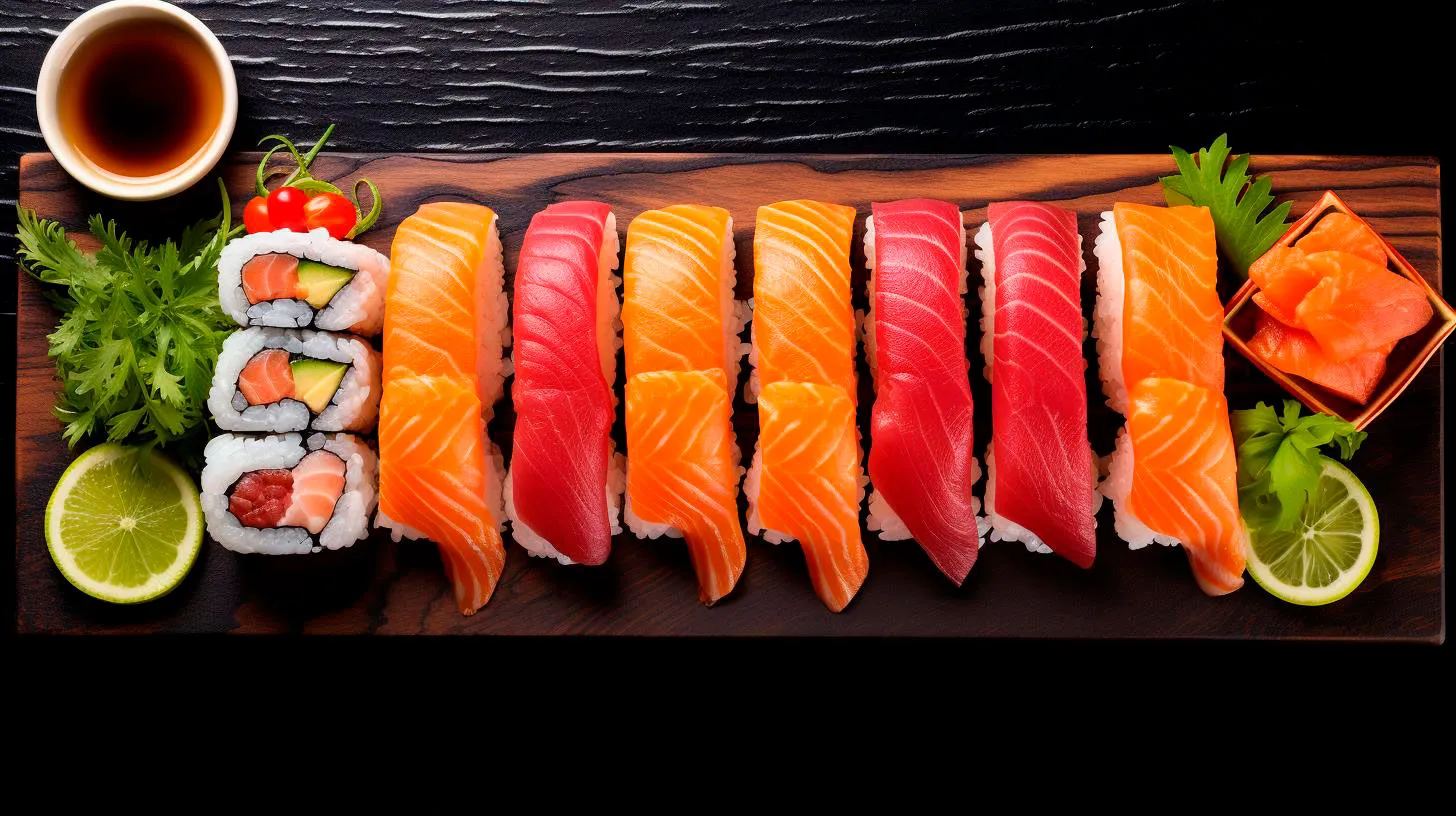Sushi Ingredient Labels: Navigating the Allergen Terminology for a Safe Dining Experience
In this article, we’ll explore the importance of navigating sushi ingredient labels and provide you with valuable insights to make informed choices when enjoying this popular Japanese cuisine.
The Basics: Understanding Sushi Ingredient Labels
Before diving into the intricacies of allergen terminology, it’s important to understand how sushi ingredient labels are typically structured. While there can be some variations, most sushi ingredient labels follow a similar pattern:
- Base Ingredient: This refers to the main ingredient of the sushi roll or piece, such as salmon, tuna, or shrimp.
- Accompaniments: These are additional ingredients added to enhance the taste and presentation, such as avocado, cucumber, or tempura flakes.
- Condiments: Sushi often comes with condiments like soy sauce, wasabi, or pickled ginger. While these may not contain allergens themselves, it’s important to be aware of any potential cross-contamination.
Now that we have a basic understanding of sushi ingredient labels, let’s delve into the allergen terminology you need to master for a safe dining experience.
Decoding Allergen Terminology for Sushi
Whether you’re allergic to specific ingredients or follow a restricted diet, understanding the following common allergen terms will greatly assist you in making informed choices:
1. Gluten
Gluten is a protein found in wheat, barley, and rye. Some common sushi ingredients that may contain gluten include:
- Tempura batter
- Imitation crabmeat (often made from fish and wheat)
- Soy sauce (regular soy sauce contains wheat)
Key takeaway: Check for gluten-containing ingredients in tempura and imitation crabmeat-based sushi rolls.
2. Shellfish
Shellfish allergies are quite common, and sushi often includes various types of shellfish. Be cautious if you have a shellfish allergy and avoid the following ingredients:
- Shrimp
- Crab
- Lobster
- Scallop
Key takeaway: Be aware of sushi rolls that contain shellfish ingredients, and opt for alternatives if you have a shellfish allergy.
3. Fish
While fish is the main ingredient in most sushi, some people may be allergic to specific types of fish. Pay attention to the following common fish allergens:
- Tuna
- Salmon
- Mackerel
- Cod
Key takeaway: If you have an allergy to certain types of fish, communicate your condition to the sushi chef and avoid consuming those specific fish.
4. Sesame
Sesame allergies are becoming more prevalent and can cause severe reactions. Keep an eye out for any sushi rolls or condiments that contain sesame seeds or sesame oil.
Key takeaway: Double-check for sesame-containing ingredients and ask the staff about the use of sesame oil in sushi preparation.
5. Tree Nuts
Tree nuts like almonds, cashews, and walnuts can be present in sushi rolls through accompaniments or garnishes. Watch out for these ingredients if you have a tree nut allergy.
Key takeaway: Scrutinize the ingredient list for any tree nut-based accompaniments like almond flakes and ask about potential cross-contamination.
The Importance of Communication
While understanding sushi ingredient labels and allergen terminology is vital, effective communication with the restaurant staff is equally important for a safe dining experience. Implement the following tips:
- Notify the server or sushi chef about your allergies or dietary restrictions before ordering.
- Ask questions about specific ingredients or potential cross-contamination risks.
- Request customization or substitution of ingredients to align with your dietary needs.
Key Takeaways
When it comes to sushi ingredient labels and allergen terminology, equipping yourself with the necessary knowledge is essential for a safe and enjoyable dining experience. Here are the key takeaways to remember:
- Understand the structure of sushi ingredient labels, including base ingredients, accompaniments, and condiments.
- Familiarize yourself with common allergen terms like gluten, shellfish, fish, sesame, and tree nuts.
- Communicate your allergies or dietary restrictions with the restaurant staff and ask relevant questions.
By navigating sushi ingredient labels and decoding allergen terminology, you can confidently indulge in this delectable cuisine while ensuring your health and well-being. Bon appétit!
Unlocking Allergy Information: Demystifying Sushi Ingredient Labels
The array of ingredients, unfamiliar names, and lack of clear explanations on sushi ingredient labels can leave you unsure about what’s safe to eat.
In this article, we aim to demystify sushi ingredient labels and provide you with the tools to navigate them confidently. Whether you’re allergic to shellfish, gluten-intolerant, or following a vegan diet, understanding sushi labels is crucial for making informed choices. So, let’s dig in and unlock the secrets of sushi ingredients!
Decoding Sushi Ingredient Labels
When you receive your plate of sushi, it’s often an assortment of different rolls, nigiri, and sashimi. Each of these can contain various ingredients, making it important to know what to look for on the label. Here are some key terms and ingredients you might come across:
- Nori: This refers to the dried seaweed used to wrap sushi rolls. It is typically gluten-free, but some brands may contain wheat, so reading the label is necessary for individuals with gluten sensitivities.
- Soy Sauce: Most sushi restaurants offer soy sauce as a condiment, but it’s important to note that it contains wheat. If you have a gluten allergy, consider opting for gluten-free tamari sauce instead.
- Wasabi: This spicy green condiment is typically made from horseradish and contains no common allergens. However, be cautious about low-quality wasabi substitutes that may contain additives or fillers.
- Sushi Rice: The base of most sushi rolls, sushi rice is made from short-grain rice seasoned with vinegar, sugar, and salt. It is usually gluten-free, but it’s always a good idea to double-check, as some brands may have additives.
Common Allergens in Sushi Ingredients
If you have allergies or dietary restrictions, being aware of the common allergens found in sushi ingredients is vital. Here are a few ingredients to watch out for:
- Shellfish: Shellfish allergies are common and can cause severe reactions. Many traditional sushi rolls contain shrimp, crab, or other shellfish. Ensure your rolls are free from any shellfish if you have this allergy.
- Gluten: Some soy sauces, imitation crab meat, and some brands of tempura contain gluten. Look for gluten-free alternatives or ask your server for options if you’re sensitive to gluten.
- Fish: Raw fish is a staple in sushi. If you have a fish allergy, avoid consuming any rolls or nigiri made with fish. Opt for vegetarian rolls or sashimi instead.
- Sesame Seeds: Sesame seeds are often sprinkled on top of sushi rolls as a garnish. If you’re allergic to sesame seeds, make sure to ask your server to omit them.
The Advantages of Clear Ingredient Labels
Clear and comprehensive ingredient labels benefit everyone, including those with dietary restrictions and allergies. Here are some advantages and key takeaways:
- Improved Safety: Detailed ingredient labels help individuals with allergies or dietary restrictions avoid potential allergens.
- Dietary Accommodations: Clear labels help sushi restaurants offer alternative options and substitutions for customers with specific dietary needs.
- Increased Confidence: With transparent ingredient labels, consumers can make informed decisions and enjoy sushi without worrying about hidden ingredients.
Overall, being informed about sushi ingredient labels is crucial for avoiding allergic reactions and making choices that align with your dietary needs. Understanding common allergens and reading labels carefully puts you in control of your dining experience. So, the next time you visit a sushi restaurant, feel confident in decoding ingredient labels and savoring the delicate flavors of this beloved cuisine.
Sources:
- Food Allergy Research & Education. (n.d.). Shellfish Allergy. Retrieved from https://www.foodallergy.org/allergens/shellfish-allergy
- BDA Food Fact Sheet. (n.d.). Irritable Bowel Syndrome (IBS) and Diet. Retrieved from https://www.bda.uk.com/foodfacts/IBS.pdf
- Merck Manual Professional Version. (n.d.). Food Hypersensitivity – Gastrointestinal Disorders. Retrieved from https://www.merckmanuals.com/en-ca/professional/gastrointestinal-disorders/food-hypersensitivity-and-intolerance/food-hypersensitivity
Understanding Sushi Ingredient Labels: A Guide for Allergy-suffering Foodies
In this comprehensive guide, we aim to help allergy-suffering foodies understand sushi ingredient labels, enabling them to make informed choices when indulging in this delectable cuisine.
The Importance of Understanding Sushi Ingredient Labels
When it comes to food allergies, knowledge is power. Understanding sushi ingredient labels is crucial for allergy-suffering foodies as it allows them to identify potential allergens and avoid them. By being aware of the ingredients used in sushi dishes, individuals with allergies can minimize their risk of experiencing allergic reactions, which can range from mild discomfort to life-threatening situations.
So, let’s dive into the details of sushi ingredient labels and how allergy-suffering foodies can navigate them with confidence.
Decoding Sushi Ingredient Labels
Sushi ingredient labels can sometimes be overwhelming, especially for those new to this cuisine. However, with a basic understanding of key terms and ingredients, you can unravel the mystery behind these labels. Here are some important aspects to consider:
1. Allergen Awareness
The first step in understanding sushi ingredient labels is being aware of common food allergens. The most frequently encountered allergens in sushi include:
- Fish and shellfish
- Soy
- Wheat (gluten)
- Eggs
- Crustaceans
- Milk
It’s essential to know which allergens you need to avoid and keep an eye out for them on sushi ingredient labels.
2. Reading and Analyzing Ingredients
When reading sushi ingredient labels, pay careful attention to the list of ingredients. Look for any potential allergens or unfamiliar terms that may indicate the presence of allergens. Keep in mind that sushi rolls often contain multiple ingredients, so analyze each component individually before making a final decision.
3. Communication with Restaurant Staff
If you have any doubts or concerns about ingredient labels, don’t hesitate to communicate with the restaurant staff. Chefs and waitstaff are usually knowledgeable about the dishes they serve and can provide valuable information regarding allergens and alternative options.
The Allergy-suffering Foodie’s Guide to Sushi Dining
While deciphering ingredient labels is important, there are additional tips that can help allergy-suffering foodies enjoy a worry-free sushi dining experience. Consider the following:
1. Choose Specialized Sushi Restaurants
Look for sushi restaurants that cater specifically to individuals with dietary restrictions and allergies. These establishments are more likely to have staff who are well-informed about allergens and can provide guidance when ordering.
2. Opt for Customization
Customizing your sushi order allows you to have control over the ingredients used. When possible, ask for a customized roll with allergen-free options or request the removal of specific ingredients that may cause a reaction.
3. Be Mindful of Cross-Contamination
Cross-contamination can occur in any kitchen, so it’s important to be mindful of this when dining out. Ensure that the utensils and cutting boards used for your sushi are thoroughly cleaned to minimize the risk of allergen cross-contact.
Key Takeaways
Sushi can be a delightful culinary experience for allergy-suffering foodies, as long as they understand sushi ingredient labels and take the necessary precautions. Here are the key takeaways:
- Knowledge of common allergens and their sources is crucial.
- Reading and analyzing sushi ingredient labels is necessary to identify potential allergens.
- Communication with restaurant staff can provide additional clarity.
- Choosing specialized sushi restaurants and customizing orders helps ensure allergen-free options.
- Being aware of cross-contamination risks contributes to a safe dining experience.
By arming yourself with these insights, you can confidently enjoy the flavors and textures of sushi while keeping your allergies in check. Bon appétit!
Decoding the Allergen Language: Making Sense of Sushi Ingredient Labels
However, these labels can often be confusing and overwhelming. In this article, we will decode the allergen language commonly found on sushi ingredient labels, empowering you to make informed choices while enjoying your sushi experience.
Understanding Common Allergens
Before we dive into the intricacies of sushi ingredient labels, let’s understand the most common allergens that are often mentioned:
- Peanuts: A widely known allergen, peanuts can cause severe allergic reactions in individuals.
- Shellfish: Shellfish allergies are prevalent, and ingredients like shrimp, crab, and lobster fall into this category.
- Fish: Fish allergies can be mild to severe and include varieties such as salmon, tuna, and mackerel.
- Wheat: Also known as gluten, wheat allergies can cause discomfort for those who are intolerant.
- Soy: Soy allergies are relatively common and are found in several sushi ingredients, including soy sauce and tofu.
- Dairy: Milk, cheese, and other dairy products are known allergens frequently mentioned on ingredient labels.
Decoding the Ingredient Labels
When you encounter a sushi ingredient label, it’s crucial to look for specific information to ensure a safe dining experience. Here’s how to decode the labels:
1. Recognize Prevalent Allergens:
Sushi ingredient labels often highlight potential allergens in bold or uppercase letters. Keep an eye out for these indications and refer back to the list of common allergens mentioned earlier.
2. Analyze the Ingredients:
Ingredient labels provide a breakdown of the components in your sushi rolls. Look for any ingredients that you are allergic to or want to avoid. Additionally, familiarize yourself with Japanese names for common allergens to easily identify them on the labels.
3. Understand Cross-Contamination Risks:
Cross-contamination is a concern for individuals with severe allergies. Sushi restaurants often use shared equipment and preparation areas, which can lead to inadvertent exposure to allergens. While ingredient labels may not explicitly mention cross-contamination risks, it is essential to communicate your allergies to the sushi chef to minimize any potential risks.
Key Takeaways for Allergy-Aware Sushi Dining
Here are some key takeaways when it comes to making sense of sushi ingredient labels:
- Familiarize yourself with common allergens and their alternative names.
- Look for bold or uppercase letters indicating potential allergens.
- Pay attention to cross-contamination risks and communicate your allergies to the sushi chef.
- Always ask questions if uncertain about any ingredient.
- Consider dining at sushi restaurants with dedicated allergy-friendly menus or informed staff.
Remember, making sense of sushi ingredient labels requires attentiveness and knowledge about potential allergens. By understanding the information provided on these labels, you can confidently navigate sushi menus, enjoy your favorite rolls, and, most importantly, keep yourself safe from any allergic reactions.



